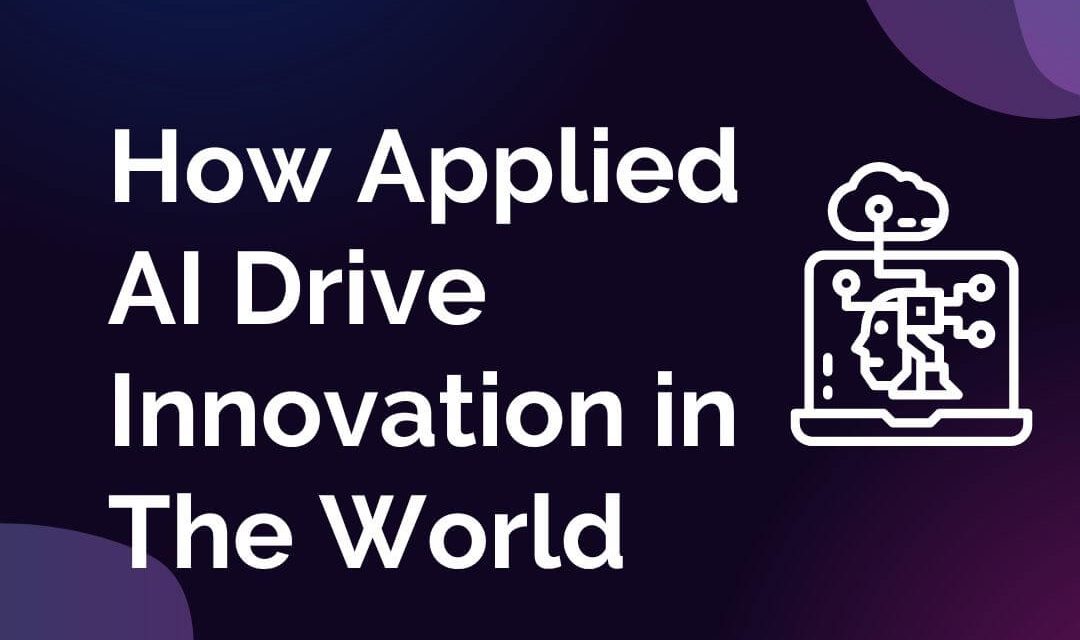Introduction
Artificial intelligence (AI) has the potential to revolutionize the way we live and work. Machine learning models can automate processes, add to or enhance capabilities and offers, and improve decision-making by resolving classification, prediction, and control issues. Companies across many sectors are starting to leverage data and insights from AI capabilities, such as machine learning (ML), computer vision, and natural language processing, to transform their operations and drive growth. According to the 2021 McKinsey Global Survey on the state of AI, 56% of respondents indicated that their organizations had implemented AI, with 27% crediting AI for at least 5% of their companies’ EBIT.
The adoption of AI is happening quickly, and it’s clear that this technology has the potential to change the way we work fundamentally. The applications of AI are vast and varied, from automating tasks and improving efficiency to driving innovation and creating new products and services. In this article, we’ll take a closer look at the benefits and challenges of applied AI and explore how different industries are already using this technology to shape the future of work. We’ll also discuss the organizational, technological, ethical, and regulatory issues that companies must consider when implementing AI and provide strategies for overcoming these challenges and maximizing the benefits of this powerful technology. So, stay tuned to learn more about the exciting possibilities and potential impact of applied AI on the future of work.
The benefits of applied AI
The benefits of applied AI are numerous and varied, and companies across many sectors are starting to realize the potential of this technology to improve operations and drive growth. Some of the key benefits of applied AI include the following:
- Automating tasks: One of the most obvious benefits of applied AI is the ability to automate tasks that are repetitive, time-consuming, or require a high degree of accuracy. For example, machine learning models can be trained to analyze large datasets, classify documents, or identify patterns in data that humans might miss. By automating these types of tasks, companies can save time, reduce errors, and free up their employees to focus on more value-added activities.
- Enhancing capabilities: Applied AI can also be used to enhance the capabilities of companies and their employees. For example, machine learning models can be used to analyze customer data and identify patterns and trends that can inform marketing strategies or sales efforts. Similarly, AI-powered chatbots can provide personalized customer support, freeing up human customer service representatives to handle more complex inquiries. Applied AI can help companies improve their efficiency and productivity by augmenting employees’ capabilities.
- Improving decision-making: AI can also be used to improve decision-making by providing insights and recommendations based on data analysis. For example, machine learning models can analyze financial data and provide investment strategies or risk management recommendations. Similarly, AI-powered systems can be used to analyze customer data and provide recommendations on targeted marketing campaigns or personalized product recommendations. By providing data-driven insights, applied AI can help companies make better, more informed decisions.
- Financial benefits: Adopting applied AI can also benefit companies significantly. According to the 2021 McKinsey Global Survey on the state of AI, 27% of respondents credited AI for at least 5% of their companies’ EBIT. In other words, using AI can directly contribute to a business’s bottom line.
In addition to these specific benefits, applied AI also has the potential to drive innovation and create new products and services. For example, machine learning models can be used to analyze customer data and identify new opportunities for product development. Similarly, AI-powered systems can be used to analyze market trends and identify new business opportunities. By driving innovation and enabling the creation of new products and services, applied AI can help companies stay ahead of the curve and maintain a competitive edge.
Overall, the benefits of applied AI are clear and wide-ranging, and companies that can implement and leverage this technology effectively are likely to see significant improvements in efficiency, productivity, and bottom-line results.
Case studies of applied AI in action
As applied AI becomes increasingly prevalent in the business world, it’s helpful to look at specific examples of how different industries use this technology to improve operations and drive growth. Below are a few case studies that highlight the diverse range of applications for applied AI:
- Retail: Retail companies are using applied AI to improve the shopping experience for customers and drive sales. For example, some retailers use machine learning models to analyze customer data and provide personalized product recommendations. Others are using AI-powered chatbots to provide real-time support to customers, answering questions and helping them find the products they need. By using applied AI to personalize the shopping experience, retailers can improve customer satisfaction and loyalty, leading to increased sales.
- Healthcare: The healthcare industry is also starting to leverage the power of applied AI to improve patient care and streamline operations. For example, some hospitals are using machine learning models to analyze medical records and identify patterns that can inform the diagnosis and treatment of diseases. Others use AI-powered systems to analyze patient data and provide personalized care recommendations. By using applied AI to improve the accuracy and efficiency of medical care, healthcare providers can improve patient outcomes and reduce costs.
- Manufacturing: Manufacturing companies use applied AI to improve efficiency and reduce costs. For example, some manufacturers use machine learning models to analyze production data and identify bottlenecks or inefficiencies in the production process. Others are using AI-powered systems to optimize supply chain operations, ensuring that the right materials are delivered to the right place at the right time. By using applied AI to streamline operations, manufacturers can reduce waste and improve efficiency, leading to cost savings and increased competitiveness.
- Financial services: Companies use applied AI to improve efficiency and reduce risk. For example, some banks use machine learning models to analyze financial data and identify patterns that can inform investment decisions. Others are using AI-powered systems to detect fraud or money laundering. By using applied AI to identify patterns and reduce risk, financial services companies can improve their bottom line and protect their customers.
- Auto-generated content: Some companies use applied AI to generate content for their websites or client projects automatically. For example, some content marketing agencies are using machine learning models to analyze customer data and identify patterns that can inform the creation of blog posts, articles, or social media posts. Others are using AI-powered systems to generate product descriptions or marketing copy. Companies can save time and resources by using applied AI to generate content and increase their output. However, it’s important to ensure that the content generated by AI is accurate and meets the desired quality standards.
These are just a few examples of the many ways that companies are using applied AI to improve operations and drive growth. As this technology becomes more prevalent, we’ll likely see even more creative and innovative uses of applied AI in various industries.
It’s worth noting that the adoption of applied AI is not without its challenges. Implementing this technology requires careful planning and a clear understanding of the organizational, technological, ethical, and regulatory issues that must be addressed. In the next section, we’ll explore some of these challenges and discuss strategies for overcoming them.
Challenges and considerations
As with any new technology, adopting applied AI is not without challenges. Companies considering implementing this technology must be aware of the organizational, technological, ethical, and regulatory issues they may face. Below are a few key challenges and considerations to keep in mind:
- Organizational issues: One of the biggest challenges of implementing applied AI is the need to align it with the overall goals and strategies of the organization. This requires clear communication and collaboration between different departments and functions, as well as developing a shared understanding of the benefits and limitations of AI. It’s also important to consider how the implementation of AI will affect the roles and responsibilities of employees and to plan for any necessary training or upskilling.
- Technological issues: There are also several technical issues that companies must consider when implementing applied AI. For example, companies must have the necessary infrastructure and data management systems to support AI use. They must also be prepared to handle the complex algorithms and large datasets that are often involved in AI projects. Finally, it’s important to have a clear understanding of the limitations of AI and to ensure that it is used appropriately rather than relying on it to make decisions that are beyond its capabilities.
- Ethical issues: The use of AI raises some ethical issues that must be carefully considered. For example, there are concerns about the potential for AI to perpetuate or amplify existing biases or discrimination. It’s important for companies to be transparent about the data and algorithms that they are using and to ensure that they are not creating or reinforcing unfair or harmful outcomes. Companies should also consider the potential impact of AI on privacy and security and take steps to protect sensitive data.
- Regulatory issues: Finally, companies must be aware of the regulatory landscape surrounding the use of AI. Depending on the industry and location, specific laws or regulations may govern the use of AI, and companies must ensure that they comply with these rules. It’s also important to consider the potential impact of AI on society and the environment and to take a responsible approach to its development and deployment.
By considering these challenges and taking a strategic and responsible approach to implementing applied AI, companies can overcome the obstacles and realize the full potential of this powerful technology. In the next section, we’ll discuss some strategies for maximizing the benefits of applied AI and minimizing the risks.
Conclusion
In conclusion, applied AI has the potential to transform the way we live and work. With its ability to automate tasks, enhance capabilities, and improve decision-making, this technology has the power to drive innovation and create new products and services. Companies across many sectors are starting to realize the benefits of applied AI, and the adoption of this technology is increasing rapidly.
However, the implementation of applied AI is not without its challenges. Companies must consider the organizational, technological, ethical, and regulatory issues that arise when implementing this technology and take a strategic and responsible approach to its development and deployment. By overcoming these challenges and maximizing the benefits of applied AI, companies can stay ahead of the curve and maintain a competitive edge in the fast-moving business world.
So, if you’re a business leader looking to stay ahead of the curve and drive growth, now is the time to explore the potential of applied AI. Don’t miss out on this exciting opportunity to transform your business and shape the future of work. Take the first step today and learn more about applied AI’s power.











Subscribe to My Newsletter
Get exclusive tips and news that I only share with my e-mail subscribers
You have Successfully Subscribed!